Crossroads of
Coincidence, part one, of 4:

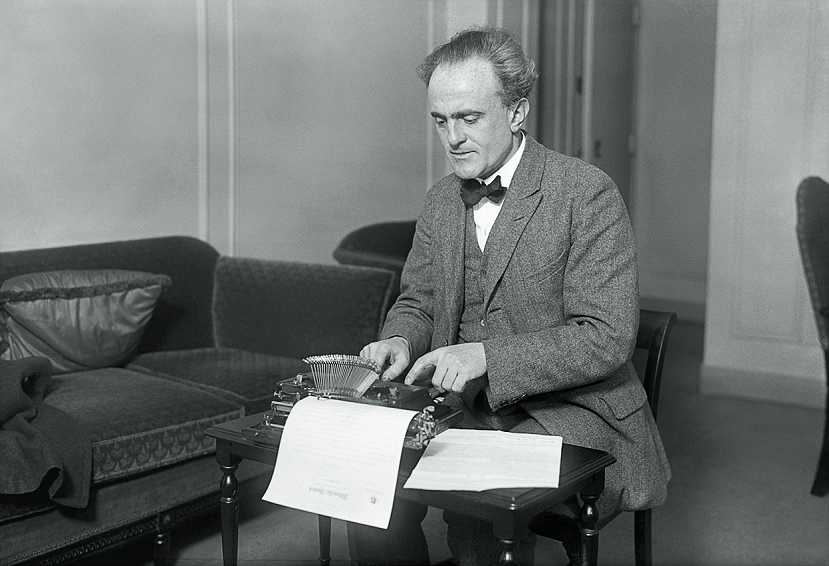
Paul
Kammerer's Law Of Series: the
key that unlocks a thousand doors...
By
John Townley, September 2019.
Part One: Preface to a Volcano
Pivotal times breed mind-bending change,
paradigm shifts, distruptive technologies and seminal ideas that can
take generations to truly understand, take hold, and accept. They are
mini-Renaissances awhirl with new music, art, spiritual fervor, social
revolution, and scientific discovery that stretch the bounds of all
previous imagination. The 1960s-70s were such a time, and we remember
its heroes (and martyrs, "Abraham, Martin, and John") as the beacons
that we still try to understand and emulate. Fifty years later, much of
the world is still struggling just to grasp (much less accept) the
ideas of universal rights, whole-world ecology, universal
interconnectivity, and the cyberworld that were imagined and brought
into being then.
Not
surprisingly, that's not the only time that has happened...little
islands of such world-changing activity sprout up regularly
across history, like Hawaii's volcanic island mounts appearing in a
string across the sea of time. And, like the Hawaiian chain, they're
not accidental, unrelated eruptions,
but tied together from below, sharing the same forces and concerns that
repeatedly surface and rebuild the foundations of the lives of
generations to come, one island at a time.

Historical hot spots are like periodic
volcanic eruptions, forming chains linked from below and within.
Recently,
these cultural eruptions seemed to have spaced themselves about
sixty years apart (a synodic Jupiter-Saturn conjunction cycle to
astrologers), with revolutionary, "interesting times": just after the
turn of the 20th century, the 1840s-50s, and back to the time of the
American and French Revolutions. A pattern worth researching further,
in another article.
But what is
of note is that the ideas of one eruption may (and do) turn out to have
similar themes to the ones before and after, which would be reasonable
if they spring from the same deep well of energy and structure. And in
one period the work of certain individuals literally "ahead of their
time" may be almost conpletely lost or ignored and not finally become
recognized until the next eruption, long after their deaths or in some
cases martyrdoms. An extreme way-back example is Christianity itself,
which arose at the peak of Roman Empire-building
revolutionizing everything, and it was either ignored or repressed
until being rather suddenly and broadly recognized several generations
later.
As a
participator and innovator in
the 1960s-70s eruption in music and later astrology,
I first imagined the broad interest in areas as disparate as
social equality,
psychic research, astrology, mysterious phenomena, drugs,
holism,
and new spiritual thinking were all something our brand-new
baby-boomer generation made up. That was until Arthur Koestler's Roots of Coincidence
(1971) revealed the very same things were all the rage in early
1900s Vienna, in a mini-Renaiisance that was cut short by World War I
and the rise of facism and communism that followed. We know (in
retrospect) what that unique revolution brought us: relativity and
quantum theory, modern psychology, socialism (the non-communist kind),
along with the distruptive technoligies of the automobile, the
airplane, and radio. And so many of its movers and shakers (Einstein,
Freud, Mahler, Shoenberg, revolutionary architects and artists like
Loos and Klimt, even would-be artist Adolf Hitler) were all vying for
attention on the streets of Vienna, whose all-comers-welcome
government made it the cultural capital of Europe. From outer
technology to
the inner journey, that was the happening place to be. It was the
center of all that was new in the rest of Europe. From cubism, to
silent film, to worldwide thinking, it was the birthplace of modernism.
It was a precursor of my own 1960s Greenwich Village.
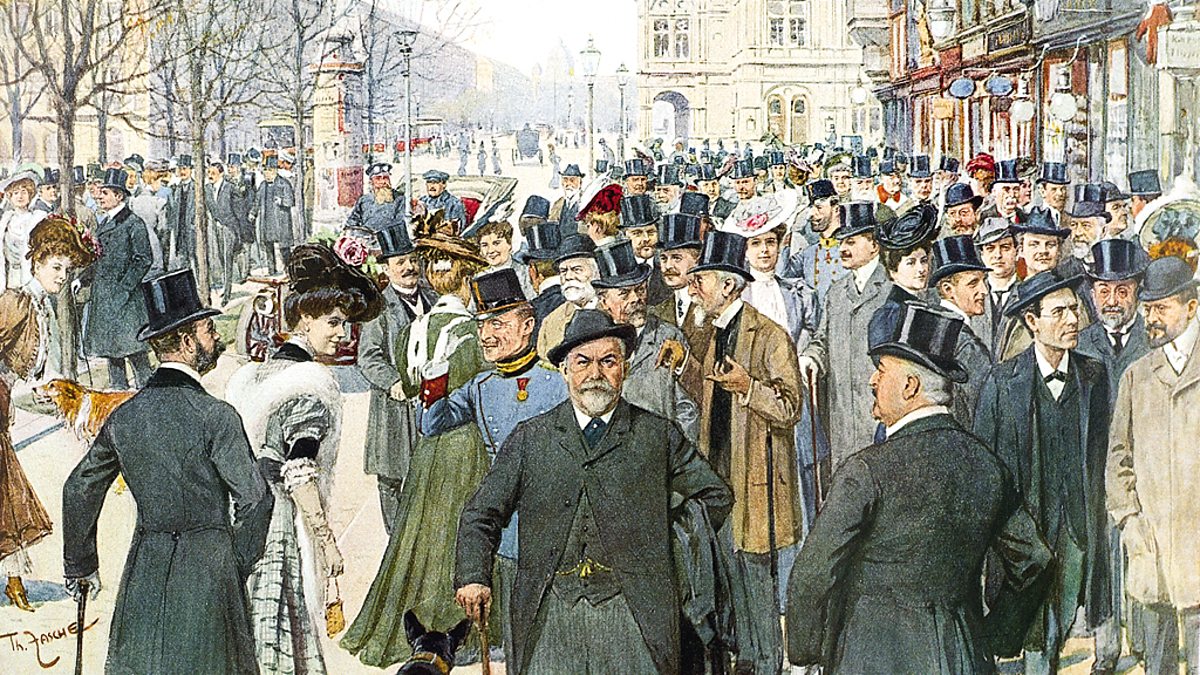

Early 20th cenutry Vienna was an echo of
cultural revolutions in 1770s, 1840s, and the 1960s yet to come.
It was
exciting to discover that -- known history in unknown Vienna. What
was more exciting was the part about the man ahead of his time, whose
ideas barely resurfaced in my time, and only now are partly being
recognized as prescient beyond his generation, and ours. That man was
Paul
Kammerer. The son of a well-to-do Jewish family, he aspired to become a
musician and disciple of composer Gustav Mahler. But instead he found
his outdoors naturalist
talents led him into biology, when he was recruited by the Vivarium,
the first-ever experimental biology institute, where the latest
theories of evolution were being tested in the laboratory.
There he became known for his breeding experiments with salamanders,
sea squirts, frogs, and other amphibians which seemed to demonstrate
that new characteristics acquired by the animals could be passed on to
their progeny. This was controversial worldwide, as it contradicted the
popular neo-Darwinian theory that developments were genetically
random and could not be acquired or passed on -- an opinion that became
standard for the entire 20th century and is only now just being
re-called into question. But when the proof of Kammerer's experiments
were shown to his peers, they grudgingly had to admit his results,
while unable to explain them. Theoretically, they seemed more similar
to the increasingly out-of-favor approach to evolution of Lamarck
rather than Darwin, though Kammerer never made such a claim.
This now
might
seem like a tempest in the teapot of early biology, but it was blown up
into repercussions of massive social importance for the time, grabbing
headlines around the world. That was because, in the fierce political
war of ideas between socialism/communism and extreme
capitalism/totalitarianism, this was wonderful fodder for the socialist
side. The idea of passing on learned experience to your kids promised a
world
of betterment-by-design, in which modern ideas of education and
behavior could actually be built-in to an improvable human race. It was
the complete opposite of of the capitalist/fascist
rule-of-the-strongest whose social engineering fantasies involved
simply killing off those with traits you disliked, while breeding
more of those you preferred. Kammerer, although personally favoring
progressive causes, wasn't ready to make sweeping, unprofessional
conclusions from simple amphibian experiments, but the press that
covered his lectures throughout Europe and America had no problem doing
so, labelling him as squarely in the socialist camp.

The Vivarium was the laboratory, known as
"The Sorcerers' Institute", where Kammerer made his magic.
This may
have ultimately spelled his demise, after World War I resulted in the
loss
of all but one of his experimental specimens (a midwife toad).
Sometime
in late 1925 or early 1926, someone tampered with that one remaining
specimen, to make it look like fraud. It was clearly intentional and
likely a setup to discredit Kammerer's work, but it did cause a
scandal, even among foes who had previously seen and admitted to the
original, untampered experiment. But by this time, the University of
Vienna
was being saturated with Nazi administrators and sympathizers who were
systematically expelling all Jewish professors and staff, and Kammerer
may have been their hardest nut to crack. That's because despite the
scandal, the Moscow Academy had decided to generously fund him to set
up his own, elaborate laboratory in Moscow, and by September of 1926
they were packing all of his expensive new equipment for shipping to
Moscow, for
a well-staffed and well-stocked project to prove inherited
characteristics. He was about to become an even greater (and
unreachable) thorn in the side
of the Austrian Nazi Party, officially formed that year.
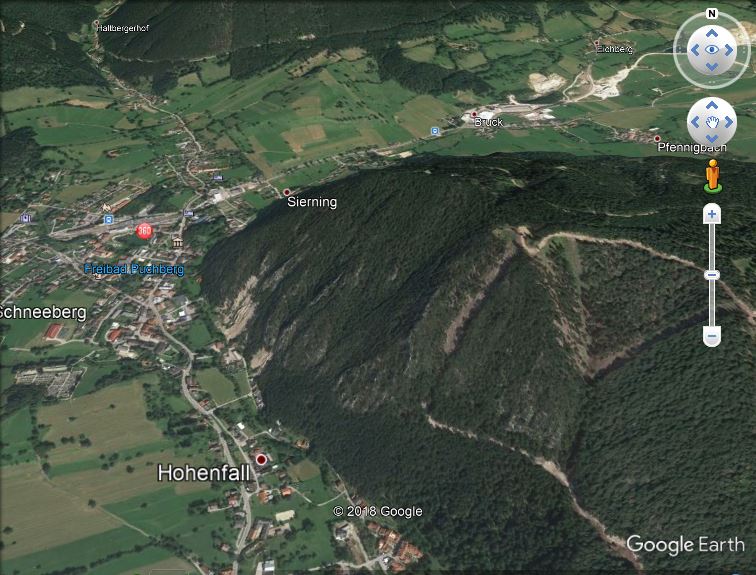
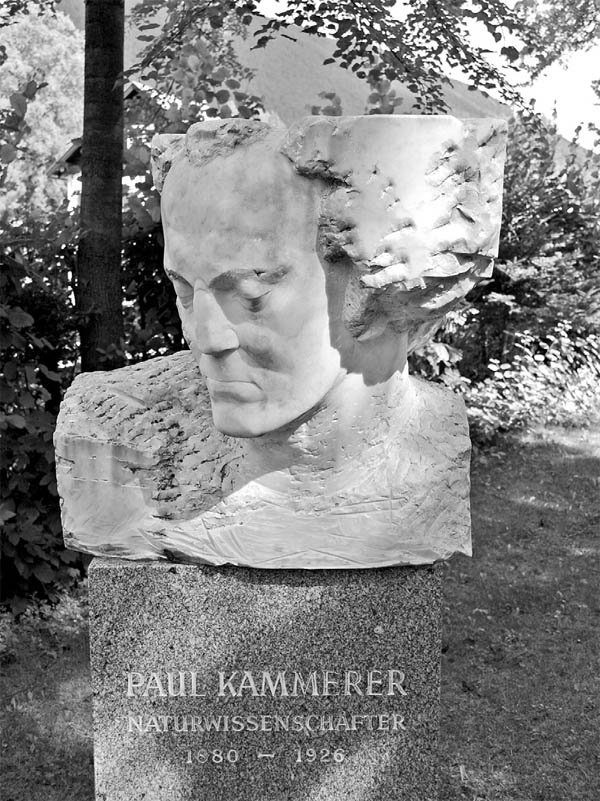
Mountain above Puchsberg, where body was
found, memorial bust at hotel where he spent his last night.
Then, just a
few days before his final trip from Vienna to Moscow for
his new career, Paul Kammerer was found shot dead on a mountainside
near Vienna. There were five typed-only suicide notes delivered to
various friends and relatives (including the Mosow Academy), and his
body was propped up against a rack, holding a pistol in his right hand,
but shot in the left temple. Despite the clearly-suspicious
circumstances, it was declared a suicide and no further investigation
was done. Was it really a suicide, or was he lured there and then shot,
a setup by powerful enemies? Just thirteen years later, another
scientist (Otto Rahn) that ran afoul of the Nazis was similarly found
dead
(and frozen) on a mountainside, which was also declared suicide. Only
Moscow would later complain, with the the 1928
production of the film Salamandra,
produced by Soviet education minister Anatoly Lunacharsky, which
clearly pointed the
finger at a facist plot -- and was immediately banned in Germany...
In the
volcano of the 1960s-'70s, Koestler's biography The Case of the Midwife Toad
alone revived Kammerer's career and questioned the events surrounding
it, to little notice.
But later, with the discovery of epigenetics at the dawn of the 21st
century
(showing that certain acquired characteristics can indeed be
inherited) , Kammerer's biology has found a new lease on life.
From a disgraced Lamarckian, he has become "the father of epigenetics".
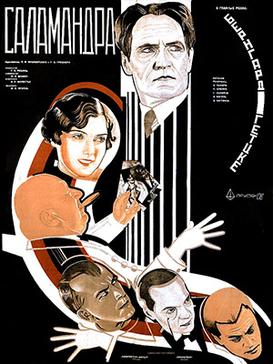

Moscow fingered Germans
in 1928 film; now vindicated, Kammerer's greatest work still awaits
recognition.
But
uncovering epigenetics was not his most important achievement! That was
his 1919 book Das Gesetz der Serie
("The Law of Series") which systematically lays down a theory of
why/how coincidences and a host of other unexplainable phenomena
happen. And that has critical bearing on all those other fields that
mark the subjects of each repeating cultural volcano: from psychology
to
physics, from the paranormal to the holistic universe, of which he
himself claimed his own work on evolution to be only a part.
Next, meet the man, his colorful life, his seminal work,
and
the book and brewing documentary/series about it, in
 Part Two...
Part Two...
click
on the link above!


